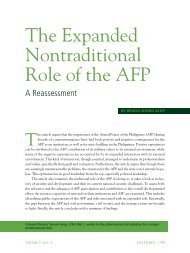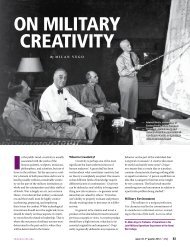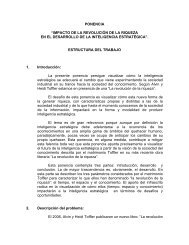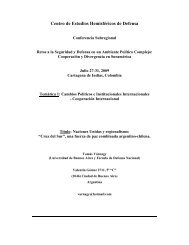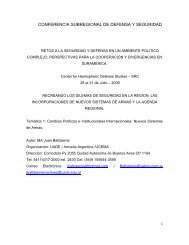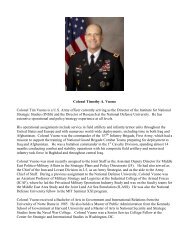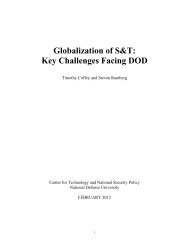On the Nature of Military Theory - National Defense University
On the Nature of Military Theory - National Defense University
On the Nature of Military Theory - National Defense University
You also want an ePaper? Increase the reach of your titles
YUMPU automatically turns print PDFs into web optimized ePapers that Google loves.
34 TOWARD A THEORY OF SPACEPOWER<br />
27 Ibid., 145.<br />
28 Ibid., 146–147.<br />
29 Carl Becker, “Everyman His Own Historian,” American Historical Review XXXVII (January<br />
1932), 221–236; reprinted in Carl L. Becker, Everyman His Own Historian: Essays on History and Politics<br />
(New York: F.S. Cr<strong>of</strong>ts, 1935), 233–255.<br />
30 Baron Antoine Henri de Jomini, The Art <strong>of</strong> War, trans. G.H. Mendell and W.P. Craighill (1862;<br />
reprint, Westport, CT: Greenwood Press, 1971), 321.<br />
31 Ibid., 323.<br />
32 Clausewitz, <strong>On</strong> War, 89. Clausewitz’s description <strong>of</strong> <strong>the</strong> three elements provides a strong indication<br />
<strong>of</strong> his lack <strong>of</strong> dogmatism: “These three tendencies are like three different codes <strong>of</strong> law, deeprooted<br />
in <strong>the</strong>ir subject and yet variable in <strong>the</strong>ir relationship to one ano<strong>the</strong>r. A <strong>the</strong>ory that ignores any<br />
one <strong>of</strong> <strong>the</strong>m or seeks to fix an arbitrary relationship between <strong>the</strong>m would conflict with reality to such<br />
an extent that for this reason alone it would be totally useless.”<br />
33 Jomini, 322. The maxims <strong>the</strong>mselves are found on page 70.<br />
34 The derivation <strong>of</strong> <strong>the</strong>se nine principles is laid out in Fuller, 208–229. Fuller named <strong>the</strong>m<br />
Direction, Concentration, Distribution, Determination, Surprise, Endurance, Mobility, Offensive Action,<br />
and Security. The U.S. Air Force’s current list <strong>of</strong> principles <strong>of</strong> war includes Unity <strong>of</strong> Command,<br />
Objective, Offensive, Mass, Maneuver, Economy <strong>of</strong> Force, Security, Surprise, and Simplicity. Air Force<br />
Basic Doctrine: AF Doctrine Document 1, November 17, 2003, 19–26, available at .<br />
Contemporary joint doctrine contains precisely <strong>the</strong> same list <strong>of</strong> <strong>the</strong><br />
principles <strong>of</strong> war as <strong>the</strong> Air Force’s but adds three “O<strong>the</strong>r Principles”: Restraint, Perseverance, and Legitimacy.<br />
Joint Publication 3–0, Joint Operations, September 17, 2006, II–2, available at .<br />
35 Jomini, 16–39. The chapter is titled “The Relation <strong>of</strong> Diplomacy to War.”<br />
36 Clausewitz, <strong>On</strong> War, 97.<br />
37 Henry M. Wriston, foreword to Henry E. Eccles, Logistics in <strong>the</strong> <strong>National</strong> <strong>Defense</strong> (1959; reprint,<br />
Washington, DC: Headquarters, United States Marine Corps, 1989), vii.<br />
38 J.C. Wylie, <strong>Military</strong> Strategy: A General <strong>Theory</strong> <strong>of</strong> Power Control (1967; reprint, Annapolis,<br />
MD: Naval Institute Press, n.d.), 31.<br />
39 For DePuy’s pivotal role in <strong>the</strong> formulation <strong>of</strong> <strong>the</strong> 1976 edition <strong>of</strong> FM 100–5 and <strong>the</strong> reaction<br />
<strong>the</strong>reto, see Romie L. Brownlee and William J. Mullen III, Changing an Army: An Oral History <strong>of</strong> General<br />
William E. DePuy, USA Retired (Carlisle Barracks, PA: United States <strong>Military</strong> History Institute, n.d.),<br />
187–189, and John L. Romjue, From Active <strong>Defense</strong> to AirLand Battle: The Development <strong>of</strong> Army Doctrine<br />
1973–1982 (Fort Monroe, VA: United States Army Training and Doctrine Command, 1984), 3–21.<br />
40 Department <strong>of</strong> <strong>the</strong> Army, Field Manual 100–5, Operations (Washington, DC: Department <strong>of</strong><br />
<strong>the</strong> Army, 1982), 1–1, 1–4, 2–1, and 11–1.<br />
41 Ibid., 2–1, 2–8.<br />
42 Ibid., 7–13 through 7–17.<br />
43 Ibid., 2–3.<br />
44 Department <strong>of</strong> <strong>the</strong> Army, Field Manual 100–5, Operations (Washington, DC: Department <strong>of</strong><br />
<strong>the</strong> Army, 1986), 10.<br />
45 Clausewitz, <strong>On</strong> War, 76. This definition, as <strong>the</strong> drafters <strong>of</strong> <strong>the</strong> manual were well aware, was<br />
much more conceptual than Jomini’s description <strong>of</strong> strategy as “<strong>the</strong> art <strong>of</strong> making war upon <strong>the</strong> map.”<br />
Jomini, Art <strong>of</strong> War, 69.<br />
46 Interview with Pr<strong>of</strong>essor Dennis M. Drew, School <strong>of</strong> Advanced Air and Space Studies, March<br />
11, 2004. In addition to an extremely detailed history <strong>of</strong> U.S. Air Force operations in <strong>the</strong> Korean War,<br />
Futrell produced a two-volume compilation titled Ideas, Concepts, Doctrine: Basic Thinking in <strong>the</strong><br />
United States Air Force (Maxwell Air Force Base, AL: Air <strong>University</strong> Press, 1989).<br />
47 Department <strong>of</strong> <strong>the</strong> Air Force, Air Force Manual 1–1, Basic Aerospace Doctrine <strong>of</strong> <strong>the</strong> United<br />
States Air Force, 2 vols. (Washington, DC: Department <strong>of</strong> <strong>the</strong> Air Force, 1992), 1:v.<br />
48 For a detailed assessment <strong>of</strong> this groundbreaking work, see Harold R. Winton, “Reflections<br />
on <strong>the</strong> Air Force’s New Manual,” <strong>Military</strong> Review 72 (November 1992), 20–31.



